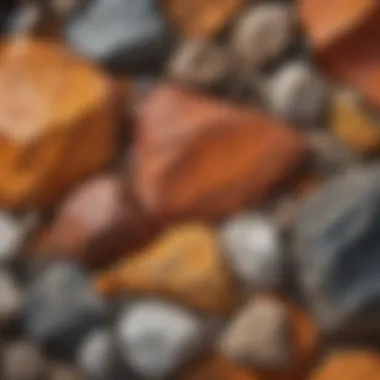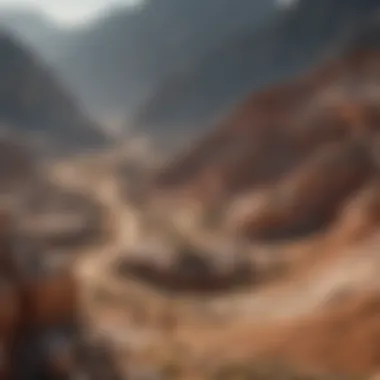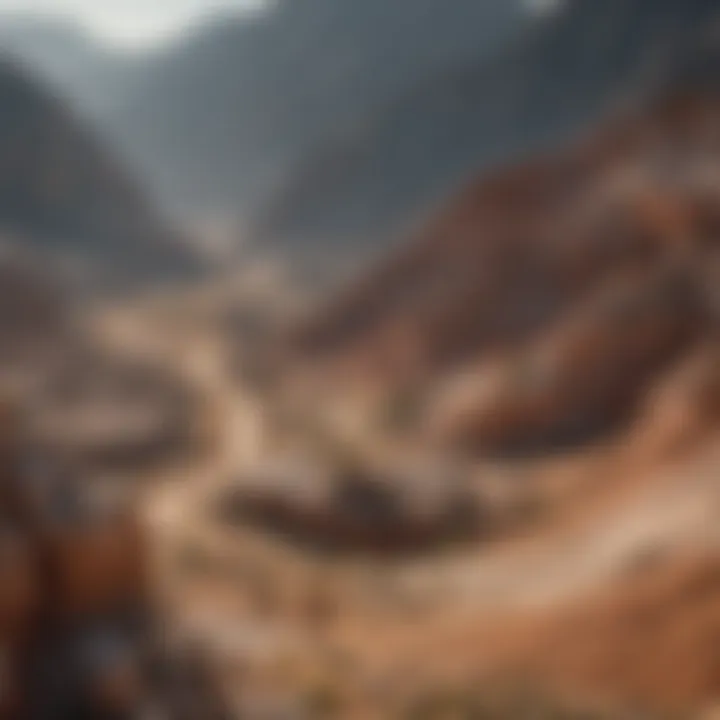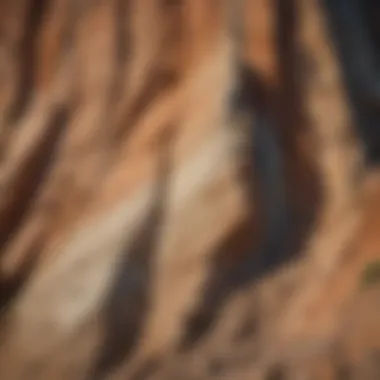Exploring Geological Aesthetics in Rock Photography


Intro
Rocks are not just inanimate objects scattered across the Earth’s surface; they tell stories, embody history, and offer glimpses into the planet's evolutionary processes. From towering mountains to humble pebbles, the variety of rocks shapes our landscapes and captures the imagination. This article is designed to guide enthusiasts and collectors alike through the captivating world of rocks as viewed through the lens of photography.
Photography, when paired with geology, transcends simple documentation. It becomes an art form that highlights textures, colors, and patterns that often go unnoticed. Diving into this intersection of art and science, we’ll explore different rock types, effective photography techniques, and how technology has expanded the way we can capture these natural wonders.
In the following sections, we will embark on a comprehensive journey that not only educates but also inspires a profound appreciation for the geological aesthetics that surround us.
Prelude to Rock Photography
Photographing rocks is more than just pointing a camera at a geological formation. It’s about capturing the essence of time etched into each stone, telling a story that's ancient yet relevant. The significance of rock photography lies in its ability to communicate the beauty, diversity, and intricate details of various rock types to a wider audience. This section serves as an entry point, highlighting the nuances and importance of understanding rocks through the lens.
Rocks capture the imagination of many, whether they are in their raw forms or polished as gems. The allure of rocks can be traced to their unique textures, colors, and patterns. Every rock holds a fragment of Earth's history. From the fiery birth of igneous rocks to the serene layering found in sedimentary types, each image taken can evoke an emotional response and draw viewers into the depths of geological science. Indeed, recounting such tales through photographs can engage not just specialists but also casual admirers.
Understanding the Appeal of Rocks
The first question that often springs to mind is: why do rocks fascinate us? It could be the swirling colors of a piece of malachite or the striking patterns found in a slice of granite. Some say the appeal lies in their perceived permanence in a world that is ever-changing. In a way, they can serve as tokens of stability amidst life's tumult.
Yet, the appeal extends beyond mere aesthetics. For collectors and photographers alike, there is a certain thrill involved in discovering unusual specimens. Each rock can be an invitation to explore geological processes - the way pressure and heat can transform matter, or how sediments deposit over aeons, building intricate layers. The tactile nature of holding a rock creates a connection, a bridge between science and personal experience.
This is why rock photography becomes powerful. It can translate complex geological stories into a visual language everyone can understand. It can summon curiosity about the Earth’s processes, encourage exploration, and instill respect for natural beauty.
Significance of Visual Representation in Geology
Visual representation is a fundamental component of geology. From textbooks to research presentations, images play a vital role in conveying complex geological concepts. A high-quality photograph can highlight not just the rock's structure but its significance in a broader geological context. For instance, a well-composed image of a volcanic rock can tell about its explosive origins and its potential impact on surrounding ecosystems.
Additionally, rock photography serves as a record of geological diversity and change. Scientists and enthusiasts alike can utilize these visuals to track shifts in geological formations over time. The importance is magnified when considering the environmental implications, as it can document areas at risk of erosion or geological surveys that indicate resource changes.
"Pictures speak a thousand words, but in geology, they can elucidate a million years of Earth's history."
Moreover, the visual representation becomes a tool for education. Educational institutions incorporate rock images into their curriculum to improve understanding among students. Visual aids can facilitate discussions, making the subject more engaging and accessible. Scholars can analyze rock features, mineral compositions, and formations that might be difficult to grasp from written descriptions alone.
In summary, rock photography not only appeals to those with a keen eye for beauty but also plays an integral role in scientific discourse, education, and fostering a profound appreciation for our natural world.
Types of Rocks
The classification of rocks is more than just sorting them into set categories; it serves as a backbone for understanding the geological timeline and the processes that shape our planet. This article section dives into the three primary types of rocks—igneous, sedimentary, and metamorphic. Each type tells a unique story about the Earth’s crust, its formation, and its transformations over time. Knowing these distinctions can greatly enhance the appreciation of rock photography, as each rock type comes with distinctive characteristics and aesthetic qualities that can be highlighted through the lens.
Igneous Rocks
Igneous rocks are created from the solidification of molten magma or lava. They offer a diverse palette of textures, colors, and formations, making them particularly captivating in photography. The two main categories are intrusive and extrusive igneous rocks, each with unique formation processes. Intrusive igneous rocks, like granite, form beneath the Earth's surface, leading to slow cooling, which leads to coarse-grained textures. Picture that grain; it could be quite dramatic in close-up photography.
On the flip side, extrusive igneous rocks, like basalt, cool quickly at the surface, resulting in fine-grained textures. This rapid cooling often traps air bubbles, giving rise to unique vesicular textures. When you capture these rocks, lighting can play a pivotal role in revealing those glossy surfaces and hidden depths.
Sedimentary Rocks
Sedimentary rocks are a window into the Earth's history, often containing fossils and layered structures that narrate tales of ancient environments. Formed through the accumulation of mineral and organic particles, they often appear in distinct strata. This layering can create appealing lines and patterns that enhance the visual aspect of your photographs.
Common examples include sandstone, limestone, and shale, each showcasing different textures and colors. Sandstone, with its warm hues and grainy surfaces, captures light beautifully, while limestone often presents a softer, more uniform appearance. When photographing sedimentary rocks, pay attention to how the light interacts with the layers; the play of light can emphasize textures you might overlook, turning an ordinary shot into something striking.
Metamorphic Rocks
Metamorphic rocks, the result of pressure and heat acting on pre-existing rocks, can yield some of the most fascinating and complex textures in geology. This category alters both the mineral content and the rock’s structure, leading to beautiful banding and foliation. Take, for instance, schist and gneiss; these rocks are often characterized by their shiny surfaces and distinct layers that shimmer in the light.
From an aesthetic perspective, the intricate patterns and colors in metamorphic rocks can evoke a sense of mystery. High-contrast images highlighting the folds and distortions can play off the natural light effectively, creating a captivating visual narrative. Plus, these rocks often carry a sense of history, as they represent the dynamic processes at work beneath our feet.
Understanding these rock types is critical for rock photography. Each comes with distinct visual traits that can tell a story, not just scientifically but artistsically. When you step into the world of geological aesthetics, knowing whether your subject is igneous, sedimentary, or metamorphic allows you to approach your photography with a clear direction, ultimately enhancing both the process and the results.
Photographic Techniques for Rocks
When it comes to capturing the essence of rocks through photography, understanding photographic techniques is paramount. The right techniques not only enhance the beauty of the subject but also convey the geological story behind each stone. Mastering these techniques lays a strong foundation for both amateur and professional photographers seeking to highlight the intricate details and aesthetic allure of geological specimens.
Choosing the Right Equipment
Selecting appropriate gear can make or break your rock photography experience. While one might think that any camera could suffice, choosing the right equipment can yield significantly better results. A quality DSLR or mirrorless camera, with exchangeable lenses, allows for versatility and precision.
A few essentials include:
- Macro Lens: Ideal for emphasizing the fine details in rock textures and mineral formations. Macro lenses allow for close-ups that capture intricate features unnoticed by the naked eye.
- Tripod: A sturdy tripod is essential for stabilizing your camera during long exposures, particularly in low-light conditions.
- Polarizing Filter: This tool helps minimize glare from rocks, revealing colors and textures that might otherwise appear washed out.


Investing in solid equipment pays off in the long run. It allows photographers to explore the vast details and colors that nature has to offer, transforming ordinary rocks into captivating subjects.
Lighting Considerations
Lighting is often said to be the heart of photography, and this rings especially true when dealing with rocky landscapes. Natural light can offer depth and texture but managing that light is crucial. The golden hours—early morning and late afternoon—provide softer light, casting gentle shadows that highlight the contours of stones.
Here are some considerations to improve your lighting setup:
- Diffused Light: Overcast days provide even, diffused light, beautifully showcasing mineral details without harsh shadows.
- Reflectors: Using reflectors can help bounce light onto your rocks, emphasizing features while balancing the picture.
- Experiment with Different Times of Day: Don’t limit yourself to one time frame. The same rock can show a vastly different personality from dawn to dusk.
Angles and Framing
Angles and framing play a critical role in how rocks are perceived in photographs. Getting on the ground or taking a high vantage point can drastically alter the perspective and interest level in your shot.
Consider these practices when working on angles and framing:
- Experiment with Composition: Use the rule of thirds to guide your compositions, allowing for dynamic arrangements that draw the viewer’s eye to your focal point.
- Close-ups vs. Wide Shots: A combo of close-ups, where textures come to life, and wide shots that show rocks within their larger geological context can tell a more complete story.
- Foreground Interest: Incorporating elements from the foreground, such as delicate wildflowers or other rocks, can frame your subject beautifully, adding depth to the image.
"Having a unique perspective can make mundane rocks come to life, revealing their beauty in ways often overlooked."
The Role of Color in Rock Photography
Color in rock photography is not just a coincidence; it's an integral part of how both enthusiasts and professionals perceive and interpret rocks. The hues, shades, and patterns found in rocks can radically change not only a photograph's aesthetic appeal but also its educational value. A photograph that captures the vibrant colors of a mineral or the subtle gradients of a sedimentary layer can lead to a deeper understanding of geological processes and the history encapsulated within those rocks.
Understanding Mineral Composition
Mineral composition is paramount when discussing color in rocks. Each mineral has a unique set of properties that contribute to its color. For instance, quartz varies widely, from clear to smoky gray, while iron-rich minerals often present striking red or yellow shades.
Understanding these relationships between minerals and colors is fundamental for any rock photographer. When capturing a rock face, observing the mineral composition allows the photographer to highlight specific colors that tell a story about the rock’s formation. An image of a granite outcrop, with its speckles of black biotite against a pale pink feldspar, conveys a narrative about volcanic activity.
- Key Elements of Color in Relation to Mineral Composition:
- Reflective Properties: Some rocks, like obsidian, can reflect light superbly, giving them an almost glassy appearance, while others, like chalk, might absorb light and appear soft.
- Chemical Impurities: The presence of specific elements can greatly influence color; for example, copper can lend a green tint to certain minerals.
In photography, these elements can be accentuated using various techniques. Tapping into the color wheel helps identify complementary colors present in your subject, enriching the overall visual experience.
Capturing Natural Textures
Textures in rock photography complement color and provide depth to images. The interplay of textures and colors can turn a standard photograph into an eye-catching piece. When a photographer captures rough, weathered surfaces alongside smooth, glossy finishes, it creates a dichotomy that intrigues viewers. The feel of the surface is almost palpable through the lens.
Natural textures can be highlighted through close-up shots, whereby the minute details of a rock's surface can be appreciated. For example, a close-up of a sandstone rock can reveal intricate layers formed over millennia, displaying colors that blend from warm yellows to rusty reds. These textured images can evoke a sense of place, connecting the viewer to the moment the photograph was taken.
- Considerations for Capturing Texture:
- Lighting: Soft, diffused light helps in revealing texture without washing out colors.
- Focus: Employing a shallow depth of field can allow the photographer to isolate textures against blurred backgrounds, treating them almost as abstract paintings.
Through careful orchestration of color and texture, rock photographers can produce compelling images that not only draw in the observer but also provide educational perspectives on the elements of geology that brought these stones together.
"A photograph isn't just an image; it's a window into the geological history that shapes our world."
In summary, understanding the role of color and texture in rock photography opens up pathways to create visually stunning and informative images. It combines artistic creativity with scientific understanding, serving both aesthetic and educational purposes for rock and fossil collectors alike.
Post-Processing Techniques
Post-processing is the art of refining and enhancing photographs after they've been captured. It's a vital stage for rock photography, as the initial image often falls short of showcasing the true beauty that lies within geological formations. This process allows the photographer to correct any missteps made during the shoot, achieve a desired aesthetic, and ultimately transform a good shot into a stunning visual representation.
By investing time in post-processing, one can underline colors, amplify textures, and highlight intricate details that might otherwise remain unnoticed. For rock and fossil collectors, presenting their geological finds in breathtaking ways through photography might entice viewers who might, at first glance, overlook the marvels of these natural objects. Thus, mastering post-processing techniques is not just a technical skill; it’s an essential part of interpreting and representing the story behind each rock.
Editing Software Options
In the world of post-processing, selecting the right software can make all the difference. Various programs suit different skill levels and needs, from effortless editing tools to professional-grade software. Here are a few popular options that many photographers swear by:
- Adobe Lightroom: Known for its user-friendly interface, Lightroom offers extensive tools for adjusting exposure, contrast, and color balance. It is especially favorable for batch editing, allowing photographers to address multiple images swiftly.
- Adobe Photoshop: Often considered the gold standard for professionals, Photoshop comes packed with advanced features for intricate editing. It’s great for detailed adjustments and creative manipulations but may have a steeper learning curve.
- GIMP: A free alternative to Photoshop, GIMP provides excellent functionality without the financial commitment. It’s perfect for those just starting, yet it holds enough depth for more experienced users.
- Affinity Photo: This affordable software has gained popularity for its range of features similar to Photoshop but without a subscription model. It offers a solid suite for both editing and retouching, making it a worthy contender.
Finding the right tool depends on the user's needs, workflow, and budget, but familiarize yourself with more than one program can open up new possibilities in your editing process.
Enhancing Details and Colors
Once the appropriate software is in hand, the real fun begins with enhancing the details and colors of your rock images. Here are some strategies that can significantly elevate your photographs:
- Adjusting Brightness and Contrast: Subtle tweaks can often breathe new life into your photos. Increasing contrast helps to delineate the textures found in rock surfaces, while careful brightness adjustments guide the viewer's eye.
- Saturation and Vibrance: Saturation deals with the intensity of colors in your image. Elevate certain hues to make the rocks pop, but be cautious—overdoing it can give an unnatural feel. Vibrance, on the other hand, intelligently adjusts colors without overly impacting skin tones, ensuring a more balanced image.
- Sharpening: Applying a sharpening filter emphasizes edges and fine details, such as the crystalline structure of minerals or the layered patterns in sediment. Keep sharpening subtle to avoid an overly digital appearance.
- Using Filters: Software often includes options for filters, like cross-processing or HDR. These can dramatically shift the feel of an image and create unique interpretations of rock formations.
- Cropping and Straightening: Sometimes, the composition needs the final touch. Cropping can refine focal points, guiding viewers directly to the elements that matter. Alternatively, a slight rotation might be required to straighten horizons or verticals, allowing for a more polished presentation.


As a whole, enhancing details and colors brings photographs to life, imbuing them with the emotional weight and narratives they deserve. Through this intimate engagement with the post-processing phase, rock photographers can capture not merely images, but stories waiting to be told.
Building a Rock Photography Portfolio
Building a rock photography portfolio is not just about showcasing your best shots; it's about telling a story through your lens. This section emphasizes how a well-curated collection can enhance your status as a serious rock photographer and attract a like-minded audience. Collectors, enthusiasts, and educators alike often search for visual representations that resonate with the underlying geology or artistry of the subject. Therefore, focusing on key elements can elevate your portfolio from a mere collection of images to a narrative that speaks volumes about your perception of rocks and their beauty.
Selecting Your Best Images
Once you’ve accumulated a range of rock photographs, the next step is selecting your best images. A strategic approach helps paint an accurate representation of your skills and artistic vision. Consider the following aspects when making your selection:
- Diversity of Subject: Include images from various rock types; igneous, sedimentary, and metamorphic rocks all offer unique textures and colors.
- Technical Quality: Ensure that the photos are sharp and clear. Blurry images can detract from the beauty of your subjects.
- Composition: Look for shots that have a strong focal point and good use of negative space. An effective composition can evoke emotions and draw the viewer in.
- Lighting: Natural lighting brings out the most in rock formations. Photos taken during the golden hour often have a more magical quality.
Evaluating your collection with these criteria can lead to a well-rounded selection. It might also be helpful to get feedback from fellow photographers or rock enthusiasts, as they might spot strengths or weaknesses you hadn’t considered.
"A great portfolio is not just a display of images, but a reflection of one's journey through rocks and their stories."
Creating a Cohesive Theme
Creating a cohesive theme within your portfolio provides clarity and allows the viewer to connect with your work on a deeper level. Start by choosing a concept or a narrative that you feel passionate about. Here are some ideas to guide your thematic choices:
- Focus on Formations: Perhaps you want to highlight different geological formations, showcasing the variety in landscapes across different regions.
- Mineral Composition: Consider photographing a diverse array of minerals and their settings to illustrate geological processes in action.
- Color Stories: You might opt for a theme that emphasizes color patterns—like the deep reds of sedimentary rocks or the cool blues of metamorphic structures.
- Seasons and Changes: Document the same location at different times of the year, capturing how the rocks change with the seasons and light.
By tying your images together through a common thread, you not only make your portfolio visually appealing but also remarkable in terms of educational value. It converts your collection into a meaningful exploration of rock aesthetics and geological significance, making it a powerful tool in today’s educational and artistic ecosystems.
Educational Value of Rock Images
The images of rocks, much more than mere snapshots of geological formations, stand as gateways to understanding the nuanced world of geology. The educational value of these visuals lies in their ability to bridge theoretical knowledge with tangible reality. Students and enthusiasts alike can glean insights into rock formation processes, mineral compositions, and environmental conditions simply by examining well-captured photographs. Furthermore, these representations serve as excellent tools in promoting critical thinking and observational skills, which are essential in scientific education.
Visual aids in geology help to illustrate concepts that might otherwise be too abstract or complex for learners at various levels. For instance, a photograph of a sedimentary rock layer can vividly depict stratification processes, while images of igneous rocks can illustrate cooling patterns and crystal formation. Enhancing the learning experience, these educational images put the rocks' stories right under the lens, so to speak, making them more accessible and relatable to the audience.
Use in Classroom Settings
In the classroom, the application of rock images fosters an engaging learning environment. For instance, teachers can utilize photographs as starting points for discussions about geological time scales or the rock cycle. By analyzing images, students can identify rock types and associated features, applying theoretical knowledge to practical examples. When students can observe the intricate details of rock formations and landscapes, they develop a deeper appreciation for geology.
Here are a few benefits of using rock images in educational settings:
- Enhanced Engagement: Visual materials capture students' interest and stimulate curiosity about geological processes.
- Improved Learning Outcomes: Studies have shown that learners retain information better when it is paired with visual aids.
- Facilitation of Group Discussions: Classmates can collaboratively analyze images, encouraging peer-to-peer learning.
- Diverse Learning Styles: Rock photos accommodate various learning preferences, particularly for visual learners who thrive on imagery.
Contribution to Online Learning Platforms
The rise of digital technology has paved the way for innovative online learning platforms to incorporate rock images into their curricula. This digital shift means that geographic and geological education can transcend traditional boundaries, reaching a global audience. Rock images enhance online courses and resources, allowing users to interact with content in a dynamic manner. Here, the visual aspect of geology not only enriches the curriculum but also makes it more interactive and engaging.
Key contributions include:
- Accessibility of Resources: Students from varying locations can access high-quality images of unique rock formations, previously only reachable through field trips.
- Self-Paced Learning: Online platforms provide flexibility for learners to explore rock formations at their own pace while utilizing photographs for guided discovery.
- Augmented Reality Features: Some platforms are beginning to experiment with augmented reality, allowing students to see geological features in a 3D format, fueling their understanding and curiosity.
- Global Collaboration: With the sharing of rock images across platforms like reddit.com or facebook.com, learners have opportunities for discussions and collaborations on geological topics that broaden their perspectives.
Through these examinations, we see that employing rock images in educational settings manifests a greater understanding of geological concepts. As students dive into the vast world of rocks and formations, they not only learn the science behind them but also cultivate a lasting enthusiasm for geology.
Digital Innovations in Rock Photography
In an era dominated by rapid technological advancements, the world of rock photography has not been left behind. Innovations are reshaping how photographers capture and present the essence of geological wonders. These digital breakthroughs not only streamline the photography process but also enhance the quality and scope of visual representation.
One of the foremost innovations is the integration of drones and 3D imaging techniques. By utilizing drones, photographers can capture aerial shots that were once cumbersome to obtain. Gone are the days of scaling rugged cliffs or relocating cumbersome equipment. Drones provide a bird’s-eye view—a perspective that showcases the vastness and intricate patterns of rock formations. This aerial dimension can highlight the relationship between geological structures and their surrounding environments in ways a terrestrial shot simply cannot.
Moreover, 3D imaging goes a step further, allowing for in-depth analysis and exploration of textures. These imaging technologies enable enthusiasts to view rocks in a more tactile manner, almost presenting a virtual reality experience of geological wonders. As blockquote indicates:
"Technology is not just about tools; it is about enhancing our ability to perceive and interpret the world, particularly in the realm of foundational beauty like geology."
Role of Drones and 3D Imaging
The incorporation of drones into rock photography has opened new doors. The ability to hover above landscapes allows photographers to explore previously inaccessible areas. For instance, rocky cliff faces or canyon depths can be documented with unparalleled detail. This has become particularly important for geological surveys and educational purposes, making complex formations easier to study. Furthermore, the high-definition capabilities of modern drones result in crystal-clear images that can reveal subtle color variations and mineral composition.
As 3D imaging develops, the merge of this technology with drones signals a significant shift in how we approach rock imagery. Think of it: a rock specimen can be scanned, and a detailed three-dimensional representation can be generated. This fosters a deeper understanding of not just what the rocks are, but how they were formed through various geological processes over millennia. Collectors can review these 3D models from every angle, providing insights that traditional photography might miss.
Mobile Photography Applications
Today, smartphones have become as powerful as traditional cameras, offering innovative mobile applications tailored for photography enthusiasts. This democratization has allowed individuals to capture stunning geological images with nothing more than a phone in hand. Various apps are designed specifically for photographers interested in geological imagery. Those include features such as HDR imaging, where contrasting colors can be balanced to enhance visibility and detail in rock textures.
Moreover, these applications often incorporate geotagging capabilities, which allow photographers to embed location data into their images. This is not just a convenient feature; it adds layers of context, turning photographs into precise geological records that document places of interest. For rock and fossil collectors, this ensures that every image tells a story—from the formation of the rock layer to its location in the field.


In essence, digital innovations are dramatically reshaping rock photography. By leveraging advancements in drone technology, 3D imaging, and mobile photography apps, enthusiasts can create a treasure trove of geological art that has both aesthetic appeal and educational value. As technology continues to evolve, so too will our understanding of rocks—not just as scientific subjects, but as profound elements of our natural world.
The Aesthetic Appeal of Rocks
The beauty of rocks stretches beyond their scientific classifications and practical uses. When diving into the aesthetic appeal of rocks, one finds elements that resonate with not just geologists, but also artists, photographers, and nature enthusiasts alike. Rocks embody history, the tales of the Earth’s movements and changes, captured in their very formations. Their textures, colors, and intricate designs serve as a testament to the natural processes that molded them over billions of years.
Exploring the aesthetic appeal isn’t merely about finding something beautiful; it encourages a deeper appreciation of Earth’s geological wonders. By recognizing the beauty in these formations, individuals become more inclined to respect and preserve the natural world. The aesthetic aspect motivates people to engage with their surroundings, capturing moments that showcase the natural art found in rocks.
Benefits of Understanding the Aesthetic Appeal
- Enhanced Observational Skills: When one focuses on rock photography, it hones the ability to notice subtle variations in colors, shapes, and textures.
- Emotional Connection: Rocks can evoke feelings tied to memories, such as a childhood adventure or a moment of serenity in nature.
- Inspiration for Creative Projects: Whether it’s painting, writing, or photography, the visual elements of rocks can inspire artistic endeavors.
In this section, we delve into two key dimensions of the aesthetic appeal of rocks: the scenic aspect revealed through nature and the captivating interpretations born from abstract perspectives.
Rocks in Nature: The Scenic Aspect
Nature’s canvas is limitless, but rocks provide a unique texture and form that can be incredibly captivating. The harmony between rock formations and their surroundings—mountains, valleys, or shorelines—creates mesmerizing landscapes that photographers strive to capture. Consider a walk along the Grand Canyon; the layers of sedimentary rock not only tell the tale of time but offer a visual feast for onlookers. The warm hues of reds and oranges interspersed with the cooler shades of blue skies and green vegetation present a picturesque backdrop.
Rocks even create dramatic contrast in otherwise homogeneous landscapes. The stark, jagged cliffs of Nahanni National Park in Canada or the massive granite peaks of Yosemite State Park evoke feelings of awe, showcasing nature's raw power. A few aspects that enhance the scenic effect of rocks include:
- Light and Shadow Play: As sunlight shifts during the day, rocks reflect varying shades and textures, inviting photographers to play with light.
- Seasonal Changes: The appearance of rocks alters throughout the year, impacted by elements like ice and snow, leaves changing color, or lush greenery.
- Ecological Context: The surrounding flora and fauna interact with rocks, sometimes creating vivid contrasts or even dependencies, enriching their display within landscapes.
Capturing this scenic beauty can provide educational insights, highlighting the importance of preservation and the fragile balance within these ecosystems.
Abstract Interpretations of Rock Features
Beyond the literal portrayal, abstract interpretations of rocks provide a fresh lens through which to appreciate their beauty. Different artists may see emotions, stories, or concepts reflected through unique designs and textures found in rocks. For instance, the spirals in a fossilized ammonite could represent the complexity of evolution and the passage of time.
Abstract rock photography often emphasizes patterns and forms, urging viewers to engage with the image differently. One may not see rocks just as solid masses, but rather as complex shapes that can evoke feelings of chaos, peace, or nostalgia. Whether aiming for intricate close-ups highlighting textural minutiae or broad vistas capturing expansive rocky landscapes, abstract interpretations can serve to deepen our understanding of both artistic expression and geological significance.
- Experiment with Composition: Focusing on unusual angles or close-ups can transform how a viewer perceives the rock, often revealing hidden beauty.
- Color Manipulations: Applying filters or adjusting hues during the editing process can enhance certain aspects, presenting an emotional response rather than a factual representation.
"The charm of rocks is often best expressed in the stories they tell—both in form and in feeling."
In the realm of photography and art, the goal should be to inspire curiosity and appreciation. This journey through the aesthetic appeal of rocks beckons audiences to not only look at them but to see them, to feel them, and to recognize the timeless beauty that these natural artifacts hold.
Ethics in Rock Photography
Considering ethics in rock photography is crucial for maintaining the integrity of both the art form and the natural environment. Photographers often find themselves at a crossroads when faced with the allure of capturing stunning geological visuals. This topic encompasses an essential aspect of responsible photography—understanding the implications of our choices when interacting with nature. Photographers need to approach their craft with sensitivity towards both the landscapes they capture and the geological formations they cherish.
Respecting Natural Landscapes
Every nook and cranny of the earth has a story etched in its varied surfaces. When photographers venture into nature, it’s easy to get swept up in the excitement and lose sight of the bigger picture, literally. Respecting natural landscapes means appreciating their beauty without putting them at risk. Here are some important considerations:
- Leave No Trace: This principle should serve as a guiding mantra. Photographers must carefully plan their trips, ensuring they don't leave behind any litter or disrupt the environment. Remember, you might think it’s a quick snap to pluck a rock for a closer look, but that could have lasting impacts on the ecosystem.
- Stick to Established Paths: Venturing off-trail in pursuit of the perfect shot may damage fragile habitats. Sticking to marked trails helps preserve the natural environment while enabling photographers to capture stunning visuals ethically.
"Nature has a way of preserving herself, keep your footprints light."
- Wildlife Considerations: Often, rocks and landscapes are home to wildlife. It’s crucial to remain aware and minimize disturbance. Making too much noise or getting too close to animals can disrupt their natural behaviors, which contributes to the on-going degradation of our natural surroundings.
Preservation of Geological Sites
Geological sites hold immense scientific and cultural value. Each rock tells a tale that traces back thousands, if not millions, of years. Preserving these sites serves not just the immediate environment but future generations. Here’s what photographers can do to safeguard these treasures:
- Understand Local Regulations: Familiarize yourself with regulations concerning rock collecting and photography in specific areas. Some places might have restrictions on photographing or collecting samples due to their significance.
- Support Conservation Efforts: When possible, contribute to or promote organizations that aim to protect geological sites. This could involve sharing your images to raise awareness or participating in workshops that focus on conservation.
- Educate Yourself and Others: Use your platform to educate others about the importance of preserving geological sites. Highlight the stories that rocks hold, creating an appreciation that transcends mere aesthetics.
Epilogue: The Journey of a Rock Photographer
As we wrap up our exploration into the world of rock photography, it's essential to take a moment and reflect on the journey that unfolds each time one picks up a camera to capture the beauty of geological formations. This journey is not merely about the act of photographing rocks but about developing a profound connection with the earth itself. Each shot taken reveals layers deep within our planet while simultaneously piecing together the natural narrative that underpins our existence.
Reflections on the Richness of Geology
The richness of geology is manifest in every rock formation, and as a photographer, embarking on this artistic endeavor means venturing into a tapestry woven from centuries of natural history. Each rock tells a story, whether it’s the cooling remnants of ancient lava or the delicate compaction of sediment layers formed through the ages. This is not just about aesthetics; it’s about understanding the environmental time capsules we’re fortunate enough to encounter.
Capturing the nuances of these geological features can evoke a sense of wonderment. Consider this: a close-up shot of a granite outcrop can reveal intricate patterns and striking color contrasts, showing how nature paints its canvas with precision and patience. The raw beauty of a weathered sandstone cliff, draped in the soft glow of the sunset, transcends mere representation.
In essence, rock photographers serve as storytellers, unraveling the geological narrative through their lenses, drawing viewers in with images that inspire curiosity about our planet's history and future.
Encouragement for Further Exploration
For those who feel a spark ignited by the art of rock photography, the journey is just beginning. Further exploration is not just encouraged; it is vital for personal growth—as well as for environmental appreciation. There's a vast world out there filled with varying rocks, minerals, and landscapes waiting to be discovered. Grab your camera, take a hike, and let nature be your muse.
Try to delve deeper into the specificities of what you photograph. Understand more about the mineral content, the geological processes that shaped the formations, and how different lighting effects can impact the appearance of your subjects. Engaging actively with the environment fosters a sense of responsibility—a commitment to preserving the very landscapes that inspire such artistry.
Joining online communities, like those on Reddit or Facebook, can be an insightful way to connect with fellow enthusiasts. Share experiences, swap tips, and learn new techniques. Let the synergy of like-minded individuals fuel your passion.
It's not just about capturing a beautiful image but also embracing the totality of the rock photography experience. Let each photograph signify not just a moment in time, but a step along an unending path of discovery, appreciation, and respect for our planet.



